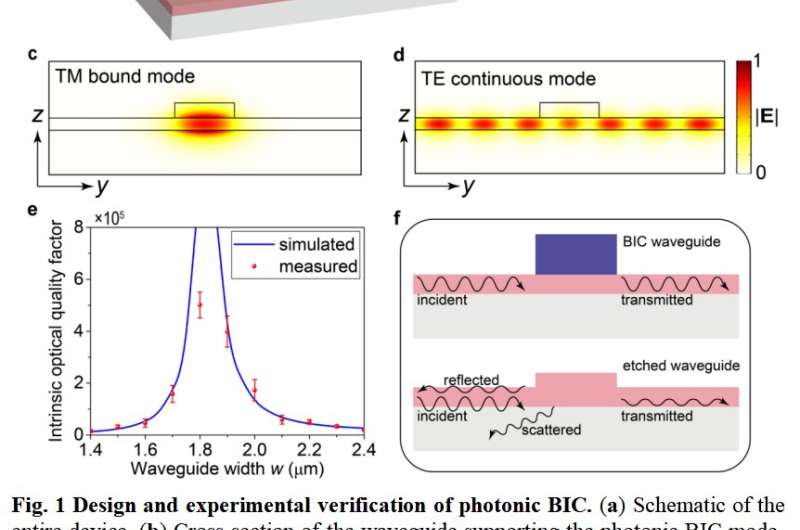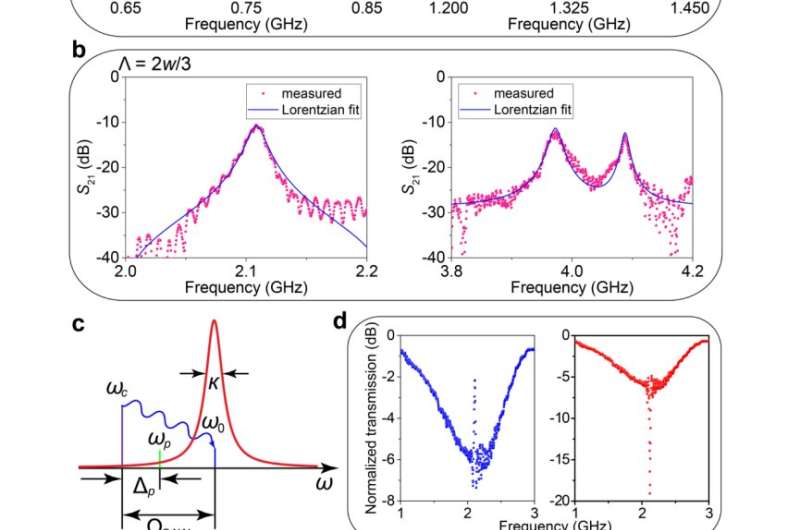(a) Schematic of the entire device. (b) Cross section of the waveguide supporting the photonic BIC mode. (c, d) Electric field |E| profiles of the TM bound mode (c) and a TE continuous mode (d) supported by the waveguide in (b). The photonic BIC mode refers to the TM bound mode (c) that under certain conditions does not interact with the TE continuous modes (d) and thus experiences zero propagation loss in the waveguide in (b). (e) Simulated and measured intrinsic optical quality factor of the cavity resonance as a function of the waveguide width w. (f) Illustration of an SAW propagating across a BIC waveguide and an etched waveguide. The etched waveguide causes reflection and scattering of the incident SAW, but the BIC waveguide does not. Credit: by Zejie Yu and Xiankai Sun
Applying bound states in the continuum (BICs) in photonic integrated circuits enables low-loss light guidance and routing in low-refractive-index waveguides on high-refractive-index substrates. Here, we demonstrate high-quality integrated lithium niobate microcavities with circulating BICs and further acousto-optically modulate these BICs by surface acoustic waves. The acousto-optic coupling is well situated in the resolved-sideband regime, which leads to coherent coupling between microwave and optical photons, as exhibited by the observed electro-acousto-optically induced transparency and absorption.
Harnessing bound states in the continuum (BICs) in photonic integrated circuits (PICs) allows for low-loss light guidance and routing with a low-refractive-index waveguide on a high-refractive-index substrate. PICs operating under the BIC principle do not require patterning micro- or nanostructures in the functional photonic material. Without the stringent requirement of high-quality etching, many single-crystal materials that exhibit excellent optical functionalities in bulk form can now be introduced to the integrated photonic platform.
Acousto-optics involves the study of phonon-photon interactions based on changes in the refractive index of a medium due to the presence of acoustic waves in that medium. Surface acoustic waves (SAWs) that propagate on surfaces of a thin-film piezoelectric material can be confined within a thickness less than the acoustic wavelength, producing phonons with a very high density in the region near the surface. The small acoustic modal area, which is comparable to the optical modal area, results in a large overlap between the two modes in photonic waveguides. Therefore, SAWs can be used to achieve strong acousto-optic interactions in nanophotonic devices.
Lithium niobate (LiNbO3) is an ideal platform for research on phonon-photon interactions because it has large piezoelectric coefficients and is optically transparent over a wide wavelength range. It can be used to generate SAWs efficiently and support photonic cavities with high quality factors. As PICs operating under the BIC mechanism allow for flexible selection of piezoelectric materials, LiNbO3 can be adopted to fabricate high-quality photonic microcavities on a chip without the need for etching.
(a, b) Measured S21 spectra for devices with SAW interdigital transducer finger period Λ = 2w (a) and Λ = 2w/3 (b). (c) Illustration of the three-wave mixing process of the control light (ωc), probe light (ωp), and SAW (ΩSAW). The cavity resonant frequency is ω0 with a decay rate of κ. (d) Measured normalized transmission spectra of the probe light, showing the features of electro-acousto-optically induced transparency and absorption Credit: Zejie Yu and Xiankai Sun
In a new paper published in Light: Science & Applications, researchers from The Chinese University of Hong Kong demonstrated a high-quality photonic microcavity based on the BIC mechanism, which was integrated with an SAW interdigital transducer monolithically on a thin-film LiNbO3-on-insulator platform. The cavity was constructed simply by patterning low-refractive-index waveguides on the high-refractive-index LiNbO3 substrate without facing the challenge of high-quality etching of LiNbO3.
The devices were fabricated on a 400-nm LiNbO3-on-insulator wafer with a standard top-down nanofabrication approach. The optical resonances of the fabricated racetrack microcavity were measured, with the highest intrinsic optical quality factor reaching ~500,000. Acousto-optic modulation of the cavity resonant BIC modes was demonstrated for the first time, with the modulation frequency exceeding 4 GHz. The combination of the high frequency of the SAW and the sub-GHz linewidth of the cavity resonance enables acousto-optic coupling in the resolved-sideband regime, yielding coherent coupling between microwave and optical photons, as evidenced by the observed electro-acousto-optically induced transparency and absorption.
The unique feature and main advantage of the present scheme are that by harnessing the low-loss light guidance under the BIC mechanism, the single-crystal LiNbO3 layer is free from etching, thus producing SAWs of uniform acoustic wavelengths and low acoustic propagation loss, which facilitates highly efficient phonon-photon coupling. The obtained strong phonon-photon coupling can be harnessed to develop a wide range of Brillouin-scattering-based photonic applications, including delay lines, light storage, microwave signal processing, Brillouin lasers and amplifiers, and nonreciprocal light transmission. Additionally, the travelling acoustic waves here were electrically excited, being much stronger than those excited by optical methods. By using a piezoelectric material, it is not necessary to fabricate delicate suspended structures similar to those in conventional on-chip stimulated-Brillouin-scattering-based devices. Therefore, our demonstrated devices have great promise in achieving high performance in Brillouin-effect-based applications with a more robust architecture.
More information: Zejie Yu et al, Acousto-optic modulation of photonic bound state in the continuum, Light: Science & Applications (2020). DOI: 10.1038/s41377-019-0231-1
Journal information: Light: Science & Applications
Provided by Changchun Institute of Optics, Fine Mechanics and Physics, Chinese Academy of Sciences

























